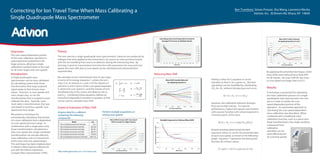
Trumbore_pittcon13_v2
- 1. Correcting for Ion Travel Time When Mass Calibrating a Single Quadrupole Mass Spectrometer Overview: The scan speed dependent portion of the mass calibration operation is automated and isolated from the larger process, allowing a single calibration transformation to be used for all mass ranges and scan speeds. Theory: Results: Introduction: Ben Trumbore, Simon Prosser, Sha Wang, Lawrence Klecha Advion, Inc. 30 Brown Rd, Ithaca, NY 14850 A single quadrupole mass spectrometer can be mass calibrated by calculating a piece-wise linear transformation that maps acquired signal peaks to their known mass values. However, as scan speeds and mass ranges vary, so can the transformation that is needed to mass calibrate the data. Typically, users must select a transformation that was calculated to work for a specific scan speed and mass range. We present a technique for automatically calculating that portion of a mass calibration that is dependent on scan speed and mass range. In combination with a single piece-wise linear transformation calculated at a slow scan speed, this single combined transformation can provide effective mass calibration over an instrument’s entire mass and scan speed ranges. This technique has been implemented in Advion’s Mass Express software for use with the Advion expression Compact Mass Spectrometer (CMS). The ions seen by a single quadrupole mass spectrometer’s detector are produced by voltages that were applied at the instrument’s ion source at some previous instant, with the ion travelling from source to detector during the intervening time. By deriving a travel (or transmission) time function with parameters for mass and scan speed, the mass shift due to scan speed can be calculated and subtracted from acquired data. We calculate an ion’s transmission time in two ways: in terms of its energy (equation 1, where the ion’s mass is m, its velocity is v, and v=d⁄t for distance d and time t) and in terms of the scan speed (equation 3, where the scan speed is s and the masses of ions simultaneously at the source and detector are ms and md ). Combining these equations defines an instrument-dependent constant k (equation 4) that can be used to calculate mass shift. (1) 1 2 𝑚𝑣2 = 𝐸 𝑑2 𝑡2 = 2𝐸 𝑚 𝑡2 ∝ 𝑚 Acquire data for a calibrant containing the following compounds: Name m/z Tetra (methyl) ammonium bromide 74.1 Tetra (butyl) ammonium bromide 242.28 Tetra (hexyl) ammonium bromide 354.41 Tetra (octyl) ammonium bromide 466.53 Tetra (decyl) ammonium bromide 578.66 Tetra (octadecyl) ammonium bromide 1027.16 Empirical Evaluation of Mass Shift Perform multiple acquisitions at varying scan speeds: Mass Shift approaches m/z 1.0 in worst case. Reducing Mass Shift Having a value for k, equation 4 can be rewritten to find ms for a given md . But that calculation can be simplified by substituting √md for √ms without introducing much error. (5) ms = md - k × s × (md ) However, the calibration behavior diverges from low to high masses. To improve performance, replace the square root function with a power function with whose exponent is a function p(m) of the mass. (6) ms = md - k × s × pow (md , p(md )) Empirical testing determined the best exponent values to use for the presented data at each scan speed, as shown in the following graph. Equation 7 represents the best power function fit to those values. (7) p(m) = 1.0173 × pow (m,-0.116) By applying the presented technique, initial mass shifts were reduced by at least 85% for all masses. No mass shift for any mass or scan speed was larger than m/z 0.1. A technique is presented for separating the mass calibration process on a single quadrupole mass spectrometer into two parts in order to isolate the scan speed-dependent portion of the operation. An automated approach to calculating the scan speed-dependent mass calibration was described. When combined with a traditional mass calibration function, such as a piece-wise linear transformation, the single resulting compound mass calibration operation can be used effectively for all scanning speeds. (2) 𝑡 = 𝑘√𝑚 (3) 𝑡 = 𝑚 𝑑 − 𝑚 𝑠 𝑠 (4) 𝑘 = 𝑚 𝑑 − 𝑚 𝑠 𝑠 √𝑚 𝑠